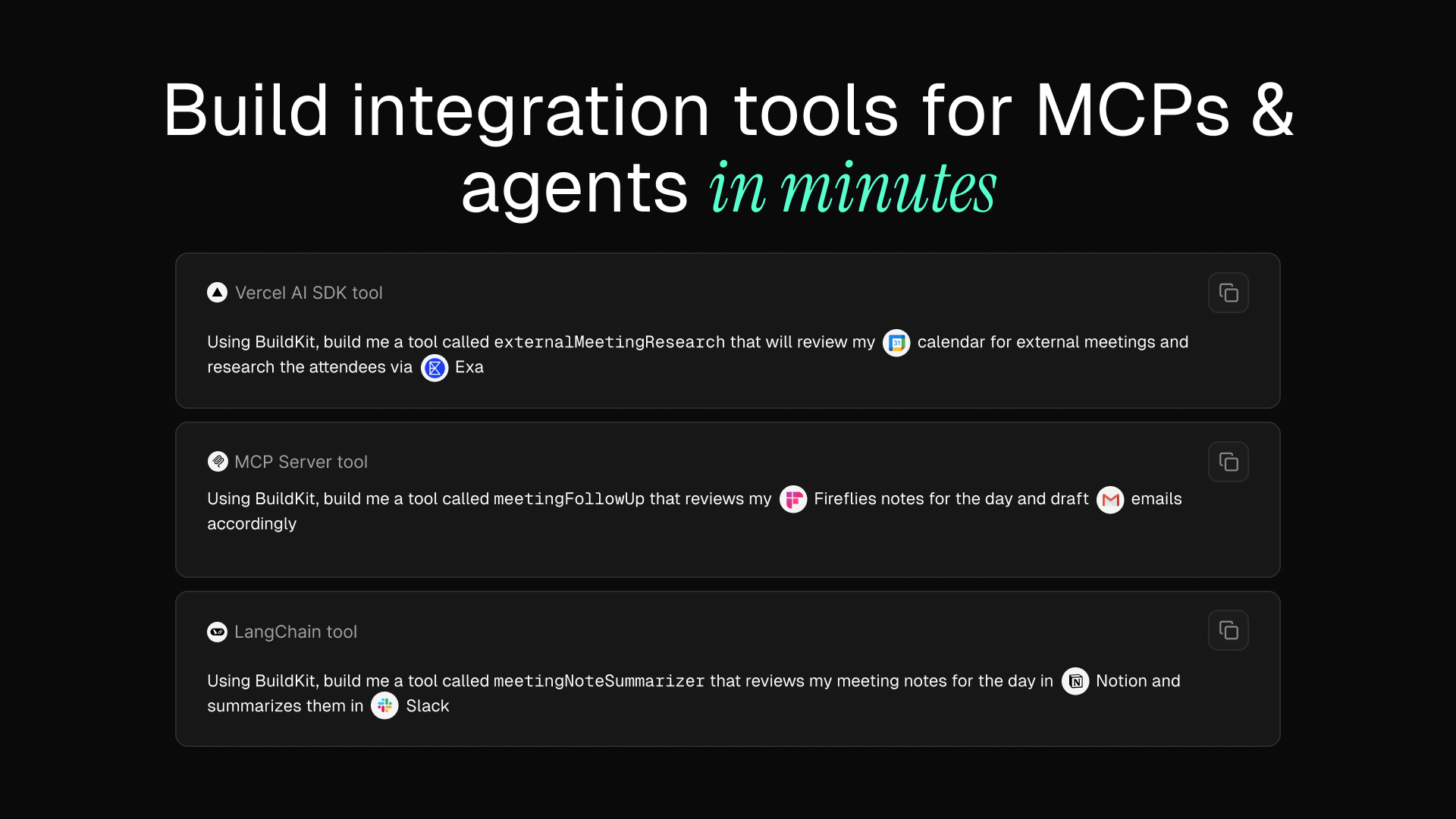Table of Contents
Overview
BuildKit 2.0 is a developer-focused platform that empowers developers to craft fully customizable, in-code AI tools and Model Context Protocol (MCP) servers with remarkable ease. Unlike traditional pre-built solutions, BuildKit 2.0 enables you to integrate powerful AI capabilities directly into your existing development environment through a single prompt interface. Whether you’re building complex agent integrations or custom logic for servers, BuildKit 2.0 accelerates your journey from concept to production.
Key Features
BuildKit 2.0 provides comprehensive features designed to streamline the creation of advanced AI tools and MCP servers for developers:
- In-code tool generation for MCPs: Generate tools and MCP servers directly within your codebase, offering significant control and flexibility over functionality and integration.
- Compatible with major development environments: Integrates seamlessly with popular frameworks including Vercel AI SDK, LangChain, and MCP-compatible environments, ensuring broad compatibility and minimizing setup requirements.
- Single-prompt creation of production-ready tools: Transform a simple, descriptive prompt into a fully functional, production-grade tool or MCP server efficiently, significantly boosting development productivity.
- Built for agent and server integration: Designed from the ground up to work effectively with AI agents and MCP servers, enhancing their capabilities and enabling sophisticated interactions.
How It Works
BuildKit 2.0 streamlines your development workflow through a straightforward process that empowers developers at every step. Developers begin by generating or writing tools and MCP servers directly in code, typically from a simple prompt that defines the desired functionality. Once these custom tools are created, they can be efficiently integrated into various agent frameworks and MCP servers. The platform’s strength lies in its ability to run these custom-built solutions seamlessly within your existing development environments, ensuring a smooth and integrated experience throughout the development lifecycle.
Use Cases
The versatility of BuildKit 2.0 creates numerous opportunities for developers looking to enhance their AI applications and integration capabilities. Key scenarios where BuildKit 2.0 excels include:
- Building connectors and custom tools for agents/MCP: Create specialized integrations for popular services like email systems, CRM platforms, and various SaaS APIs, enabling your agents to interact effectively with external systems and perform specific tasks.
- Rapidly deploying integration logic for production: Accelerate your development cycle by quickly building and deploying sophisticated integration logic directly in code, achieving production readiness efficiently while ensuring robust performance.
Advantages and Considerations
Advantages
- Maximum flexibility through in-code tools and MCP integration: Gain comprehensive control over your AI tools and their integration, adapting them precisely to your specific requirements and use cases.
- Integration across major development environments: Enjoy broad compatibility, as BuildKit 2.0 works seamlessly with popular development setups and AI frameworks currently in use.
- Developer-centric approach: Empowers developers with the tools and autonomy to build exactly what they envision, fostering innovation and precision in implementation.
Considerations
- Developer skills required: This platform is designed for users with coding expertise, making it unsuitable for non-technical users or those without programming knowledge.
- Code-first approach: Users who prefer drag-and-drop interfaces and visual builders may find BuildKit 2.0’s in-code methodology less aligned with their preferred workflow.
How Does It Compare?
When evaluating BuildKit 2.0 against current competitors in the AI development landscape, several distinctions emerge. The 2025 market includes various approaches to AI tool development:
No-code/Low-code Platforms such as Lindy AI, Relevance AI, and Botpress offer simplicity and accessibility for non-developers through drag-and-drop interfaces and visual workflow builders. These platforms excel in rapid deployment and ease of use for business users.
Multi-agent Frameworks like CrewAI, AutoGen, and LangChain provide different approaches to AI system development. CrewAI focuses on team-based agent orchestration, AutoGen specializes in conversational multi-agent systems, while LangChain offers extensive integrations and modular development capabilities.
Enterprise Platforms including Microsoft Copilot Studio and Stack AI target business workflow automation with enterprise-grade features and compliance capabilities.
BuildKit 2.0 differentiates itself by providing a code-first, MCP-focused approach that gives developers granular control over AI tool creation. While no-code solutions prioritize accessibility and rapid deployment, BuildKit 2.0 emphasizes customization, technical depth, and seamless integration within existing development environments. This developer-first philosophy enables faster progression from prompt to production-ready tool for technical teams who require deep control, high performance, and sophisticated integration capabilities.
Enhanced Analysis and Missing Information
Based on current market research, several important considerations should be noted:
MCP Ecosystem Context
The Model Context Protocol represents a significant standardization effort in AI development, originally introduced by Anthropic in late 2024. MCP provides a standardized interface for AI models to interact with external data sources and tools, similar to how USB-C standardizes device connections. This protocol has gained rapid adoption across major development platforms including Cursor, Replit, Zed, and Sourcegraph.
Technical Architecture
BuildKit 2.0 operates within the broader ecosystem of AI development tools by focusing specifically on MCP server creation and tool generation. The platform leverages the growing MCP standard to enable more interoperable AI tool development, which is particularly valuable as the industry moves toward standardized AI-external system interfaces.
Market Position
In the rapidly evolving AI development tool landscape of 2025, BuildKit 2.0 occupies a unique position by combining the accessibility of prompt-based generation with the power of code-level customization. This hybrid approach bridges the gap between fully no-code solutions and traditional development frameworks.
Final Thoughts
BuildKit 2.0 represents a focused solution for developers building sophisticated, custom AI tools and MCP servers. Its emphasis on in-code generation, compatibility with major frameworks, and rapid deployment capabilities positions it as a valuable tool for technical teams looking to leverage the emerging MCP standard. While it specifically targets the developer community, its combination of prompt-based simplicity and code-level control makes it a compelling option in the evolving landscape of AI development tools, particularly for teams requiring production-ready applications with deep customization capabilities.
The platform’s success will likely depend on the continued adoption of the MCP standard and its ability to maintain compatibility with the rapidly evolving AI framework ecosystem while providing the developer experience and flexibility that technical teams require for complex AI integrations.
